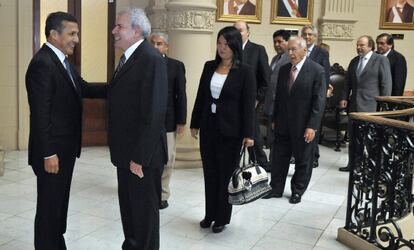Chile and Peru strengthen ties as both nations await ruling on maritime dispute
International Court of Justice to decide on Pacific boundary markers next week

With less than a week to go before the International Court of Justice (ICJ) hands down a long-awaited ruling in a sensitive maritime case, which has tarnished relations between Chile and Peru, the two governments have already begun to try to patch up their ties despite the impact the final resolution of that dispute could have.
When Chile’s government found out in 2006 that Peru was planning on filing a complaint with the court in The Hague, a diplomatic initiative set up by the two governments known as 2+2 was suspended. But seven years later, in 2013, talks between the country’s two foreign ministers and defense chiefs resumed.
In spite of the upcoming decision, which has both governments on edge, Peru and Chile have placed a new emphasis on their joint relations.
Peruvian President Ollanta Humala has been holding meetings with his advisors, including a mini-summit last week with all of the country’s former presidents. In Santiago, President Sebastián Piñeda called his national security team together on Monday to analyze the possible implications the ruling may have on relations.
In 2008, Peru filed a lawsuit with the ICJ demanding that the justices establish new boundary lines in the Pacific and award it some 35,000 square kilometers of maritime rights, something that had not been negotiated in the past. Chile, on the other hand, states that the treaties signed in 1952 and 1954 both agreed to the current maritime limits. But the Peruvian government has described those treaties as mere fishing agreements.
Since 2011, the two countries have been members of the Pacific Alliance trade bloc, which also includes Colombia and Mexico, and has recently begun to allow certain products and services to circulate among the four nations. The next Pacific Alliance summit will be held in Cartagena, Colombia in early February after the decision is handed down.
Both countries have historical ties, including among their people. Peruvians resident in Chile make up one-third of the foreign-born population living in that country, while many Chileans have also crossed the border to work in Peru.
Both sides have also made efforts to strengthen ties between their border areas of Tacna, Peru and Arica Chile, where around 5,000 crossings occur annually. In 2013, a summit between Catholic bishops and opinion-makers from both nations was held in Tacna and Arica, aimed at “bolstering relations and cooperation.”
But the two sides also warned of the “fragility and ambiguity centered only on the trade and political circles” of their joint relations and called for more sectors to become involved in strengthening ties.
Since the case began at The Hague, media in both nations have reported how Chileans take advantage of the low-cost healthcare in Peru, while Peruvians look for bargain prices for appliances and textiles.
Both presidents have said they will respect the ICJ’s eventual decision in the case.
Tu suscripción se está usando en otro dispositivo
¿Quieres añadir otro usuario a tu suscripción?
Si continúas leyendo en este dispositivo, no se podrá leer en el otro.
FlechaTu suscripción se está usando en otro dispositivo y solo puedes acceder a EL PAÍS desde un dispositivo a la vez.
Si quieres compartir tu cuenta, cambia tu suscripción a la modalidad Premium, así podrás añadir otro usuario. Cada uno accederá con su propia cuenta de email, lo que os permitirá personalizar vuestra experiencia en EL PAÍS.
¿Tienes una suscripción de empresa? Accede aquí para contratar más cuentas.
En el caso de no saber quién está usando tu cuenta, te recomendamos cambiar tu contraseña aquí.
Si decides continuar compartiendo tu cuenta, este mensaje se mostrará en tu dispositivo y en el de la otra persona que está usando tu cuenta de forma indefinida, afectando a tu experiencia de lectura. Puedes consultar aquí los términos y condiciones de la suscripción digital.
Últimas noticias
Pinochet’s victims grapple with José Antonio Kast’s rise in Chile
Reinhard Genzel, Nobel laureate in physics: ‘One-minute videos will never give you the truth’
How Japan is trying to avert ‘digital defeat’
The complicated life of Francesca Albanese: A rising figure in Italy but barred from every bank by Trump’s sanctions
Most viewed
- Pablo Escobar’s hippos: A serious environmental problem, 40 years on
- Why we lost the habit of sleeping in two segments and how that changed our sense of time
- Charles Dubouloz, mountaineering star, retires at 36 with a farewell tour inspired by Walter Bonatti
- Trump’s obsession with putting his name on everything is unprecedented in the United States
- The Florida Keys tourist paradise is besieged by immigration agents: ‘We’ve never seen anything like this’








































